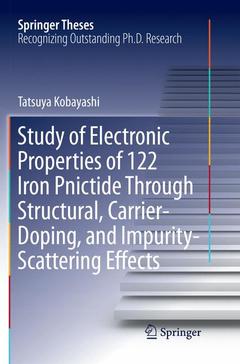Description
Study of Electronic Properties of 122 Iron Pnictide Through Structural, Carrier-Doping, and Impurity-Scattering Effects, 1st ed. 2017
Springer Theses Series
Language: English
Subject for Study of Electronic Properties of 122 Iron Pnictide...:
Publication date: 12-2018
Support: Print on demand
Publication date: 05-2017
Support: Print on demand
Description
/li>Contents
/li>Biography
/li>Comment
/li>
This thesis presents various characteristics of 122-type iron pnictide (FeSC) such as crystal and electronic structure, carrier-doping effect, and impurity-scattering effect, using transport, magnetization, specific heat, single-crystal X-ray diffraction, and optical spectral measurements. Most notably the measurement on the magnetic fluctuation in the material successfully explains already known unusual electronic properties, i.e., superconducting gap symmetry, anisotropy of in-plane resistivity in layered structure, and charge dynamics; and comparing them with those of normal phase, the controversial problems in FeSCs are eventually settled.
The thesis provides broad coverage of the physics of FeSCs both in the normal and superconducting phase, and readers therefore benefit from the efficient up-to-date study of FeSCs in this thesis. An additional attraction is the detailed description of the experimental result critical for the controversial problems remaining since the discovery of FeSC in 2008, which helps readers follow up recent developments in superconductor research.
Introduction.- Experimental Methods.- Electronic Phase Diagram and Superconducting Property of SrFe2(As1-xPx)2.- In-Plane Resistivity Anisotropy of Ba(Fe1-xTMx)2As2 (TM=Cr, Mn, and Co).- Optical Properties of Ba(Fe1-xTMx)2As2 (TM=Cr, Mn, and Co).- Conclusion.
Tatsuya Kobayashi is an experimentalist in condensed-matter physics, and his work is concerned with strongly correlated electron systems and iron-based superconductors.
Tatsuya Kobayashi received a Bachelor of Science, Master of Science, and Ph.D. from the Department of Physics, Graduate School of Science, Osaka University in 2011, 2013, and 2016, respectively. During his graduate program, he joined the group led by Professor Setsuko Tajima in the Department of Physics, Osaka University. Between April 2014 and March 2016, he was awarded a research fellowship for young scientists (DC2) by the Japan Society for the Promotion of Science (JSPS), and his research was supported by JSPS.




